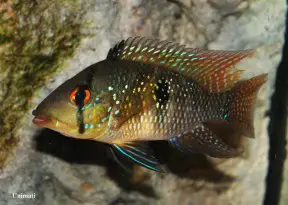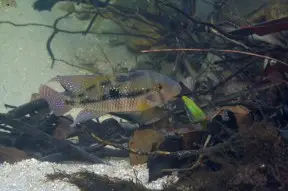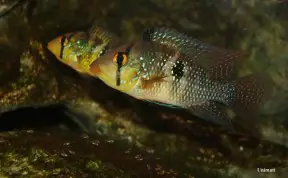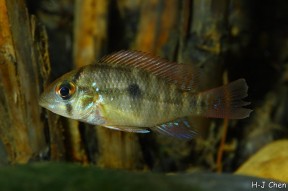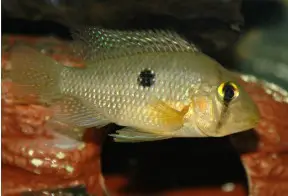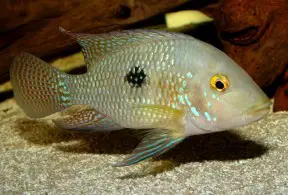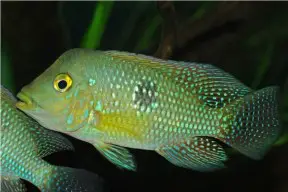'Geophagus' brasiliensis
Pearl Cichlid
SynonymsTop ↑
Chromis brasiliensis Quoy & Gaimard, 1824; Chromys unimaculata Castelnau, 1855; Acara gymnopoma Günther, 1862; Geophagus brasiliensis Kner, 1865; Acara minuta Hensel, 1870; Geophagus tuberosus Gosse, 1976; Geophagus olfersi Gosse, 1976
Etymology
brasiliensis: ‘of Brazil’.
Classification
Order: Perciformes Family: Cichlidae
Distribution
Native to river systems of eastern and southern Brazil and Uruguay draining into the Atlantic Ocean with type locality given as ‘Rio de Janeiro Bay, Brazil’.
In Brazil it’s been recorded from various river drainages and lagoons in the states of Minas Gerais, Espírito Santo, Rio de Janeiro, São Paolo, Paraná, Santa Catarina and Rio Grande do Sol while in the Uruguay it occurs in the Río Uruguay and Río de la Plata drainages.
Non-native populations exist in several countries including the United States, Australia, Taiwan and the Philippines.
Habitat
Most often recorded in coastal drainages and the lower reaches of rivers, and some populations inhabit coastal lagoons with permanent or temporary connections to the ocean so have evolved a degree of salt tolerance.
It’s perhaps best described as a habitat generalist since it’s been recorded from biotopes with varying levels of water movement and turbidity, from fast-flowing to stagnant and crystal clear to impenetrable, respectively, and different substrate-types.
Maximum Standard Length
Males to 200 – 250 mm; females 130 – 150 mm.
Aquarium SizeTop ↑
Minimum base dimensions of 150 ∗ 45 cm or equivalent are required for long-term care.
Maintenance
Ideally a soft, sandy substrate should be employed though it’s not essential.
Additional furnishings are as much a case of personal taste as anything else but the most favoured set-ups tend to feature relatively dim lighting plus some chunks of driftwood and scattered roots or branches.
One or two flattish, water-worn rocks can also be included to provide potential spawning sites if you wish.
Water quality is of the utmost importance since these cichlids are susceptible to deteriorating water quality and should never be introduced to a biologically immature aquarium.
The best way to achieve the desired stability is to over-filter the tank using a combination of external canister filters and/or a sump system and perform minimum weekly water changes of 50-70%.
If the maintenance regime or diet is insufficient individuals may develop health problems such as head and lateral line erosion or exhibit stunted growth.
Mechanical filtration should be tailored to trap small particles stirred up by the fish as sand can cause blockages and wearing issues with filter mechanisms if allowed to continually run through the system.
Water Conditions
Temperature: 18 – 28 °C
pH: 6.0 – 8.0
Hardness: 18 – 268 ppm
Diet
Studies have revealed it to be a generalised omnivore with the natural diet composed of plant material, aquatic invertebrates (particularly chironomid larvae, ostracods and cladocerans), fish scales and fry.
Although often referred to as an ‘eartheater’ this species isn’t as benthophagous as members of Geophagus though mouthfuls of substrate are sometimes taken and sifted for edible items.
In the aquarium offer good quality, sinking dry foods as staple alongside regular meals of live or frozen bloodworm, Artemia, etc.
Behaviour and CompatibilityTop ↑
Males are territorial, particularly when spawning, while very small tankmates may be predated upon.
Sexual Dimorphism
Males grow larger than females, often significantly so, and most dominant specimens develop a nuchal hump to some extent.
Reproduction
Biparental substrate spawner.
NotesTop ↑
This species is also known as the ‘pearlscale’ or ‘mother-of-pearl’ cichlid in deference to the iridescent body scaling.
It’s also worth noting that fishes sold as Gymnogeophagus australis in Europe are ‘G.‘ brasiliensis more often than not.
Wild specimens exhibits significant dissimilarities in body colour and patterning depending on locality with basic colouration being dominated by varying shades of blue, green or yellow, for example.
Some populations also exhibit differences in body shape depending on the type of environment they inhabit, e.g., specimens from fast-flowing rivers and tributaries are more elongate than those from sluggish or stagnant waters.
It’s possible that the species as currently recognised may turn out to represent a group of closely-related taxa should additional studies be conducted.
The genus Geophagus was rediagnosed by Kullander (1986) who restricted it to include only those species with paired caudal extensions to the swimbladder lined by 6-12 epihemal ‘ribs’ plus a greater number of caudal than abdominal vertebrae.
Some former species were moved into the resurrected genus Satanoperca while others, such as the ‘Geophagus‘ brasiliensis and ‘G.‘ steindachneri groups represent distinct groupings still in need of definitive classification.
Geophagus and a number of related genera are often included in the putative subfamily Geophaginae.
Kullander (1998) conducted a morphology-based phylogenetic study in which the neotropical Cichlidae was divided into six subfamilies of which the Geophaginae contained 16 genera divided among three ‘tribes’:
Acarichthyini – Acarichthys and Guianacara.
Crenicaratini – Biotoecus, Crenicara, Dicrossus and Mazarunia.
Geophagini – Geophagus, Mikrogeophagus, ‘Geophagus‘ brasiliensis group, ‘Geophagus‘ steindachneri group, Gymnogeophagus, Satanoperca, Biotodoma, Apistogramma, Apistogrammoides and Taeniacara.
Later molecular studies by Farias et al. (1999, 2000, 2001) resulted in the additions of Crenicichla and Teleocichla to the Geophaginae, a result supported by López-Fernández et al. (2005) who conducted the most detailed molecular analysis of the grouping to date including 16 of the 18 genera and 30 species.
However their conclusions regarding interrelationships between genera did vary somewhat from previous hypotheses and can be summarised by the following loosely-defined groups:
– a weakly-supported sister group relationship between Acarichthys and Guianacara.
– a well-supported “Satanoperca clade” comprising Satanoperca, Apistogramma, Apistogrammoides and Taeniacara.
– a “big clade” with Geophagus, Mikrogeophagus, ‘Geophagus‘ brasiliensis group, ‘Geophagus‘ steindachneri group, Gymnogeophagus, Biotodoma, Crenicara and Dicrossus.
– a “crenicarine clade” with Biotoecus and Crenicichla.
No representatives of Teleocichla or Mazarunia were included in the study but the former is well-established as sister to Crenicichla while the latter has grouped closely with Dicrossus and Crenicara in earlier works.
The other main conclusions of the paper are confirmation that Geophaginae is a monophyletic group exhibiting strong signs of having undergone rapid adaptive radiation.
References
- Farias, I. P., G. Ortí and A. Meyer, 2000 - The Journal of Experimental Zoology 288(1): 76-92
Total evidence: molecules, morphology, and the phylogenetics of cichlid fishes. - Farias, I. P., G. Ortí, I. Sampaio, H. Schneider and A. Meyer, 1999 - Journal of Molecular Evolution 48(6): 703-711
Mitochondrial DNA phylogeny of the family Cichlidae: monophyly and fast molecular evolution of the Neotropical assemblage. - Farias, I.P., G. Ortí, I. Sampaio, H. Schneider and A. Meyer, 2001 - Journal of Molecular Evolution 53(2): 89-103
The cytochrome b gene as a phylogenetic marker: the limits of resolution for analyzing relationships among cichlid fishes. - López-Fernández, H., R. L. Honeycutt, M. L. J. Stiassny and K. O. Winemiller, 2005 - Zoologica Scripta 34(6): 627-651
Morphology, molecules, and character congruence in the phylogeny of South American geophagine cichlids (Perciformes, Labroidei). - Reis, R. E., S. O. Kullander and C. J. Ferraris, Jr. (eds), 2003 - EDIPUCRS, Porto Alegre: i-xi + 1-729
Checklist of the Freshwater Fishes of South and Central America. CLOFFSCA.
